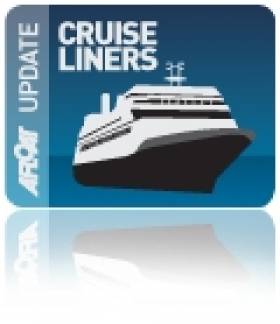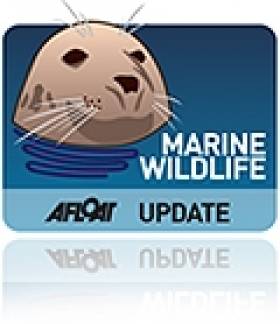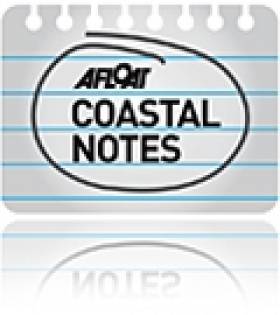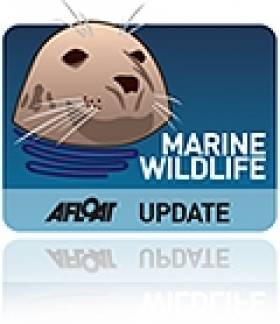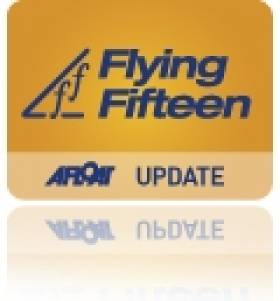Displaying items by tag: Strangford Lough
Tidal Energy Turbine to Be Removed from Strangford Lough
#TurbineToGo - A tidal energy turbine is to be removed from Strangford Lough, Co. Down, reports BBC News.
The SeaGen turbine was lowered into place in 2008 (see report photo) and generates electricity from tidal currents.
Two horizontal axis turbines are anchored to the seabed and are driven by the powerful currents resulting from the tide moving in and out.
Its owners Atlantis Resources (only since July, 2015) said it will be decommissioned later this year.
The company said it had been "an essential research and design platform".
Stephen Ward, the firm's director of power generation, said: "This year, we will embark on the next stage of the R&D (research and development) process and focus on decommissioning the SeaGen device.
"This operation will be the first commercial scale turbine development to be decommissioned and will help us to understand the complete life-cycle of a tidal stream development."
Strangford Lough To Host Coastal Rowing 'Skiffie' World Championships
Strangford Lough will stage the coastal rowing Skiffie World Championships 2016 this July.
Canada, England, New Zealand, Northern Ireland, Scotland, Tasmania, USA, Wales will bring a truly international flavour to the six day rowing event featuring 22ft, traditionally styled, wooden St Ayles skiffs, rowed by teams of four people plus cox.
Strangford Lough and Lecale Partnership, Scottish Coastal Rowing Association, Newry, Mourne and Down District Council and Ards and North Down Borough Council will welcome the coastal rowers to Strangford Lough from 24 -30 July 2016
All of the St Ayles’ skiffs have been built within their communities, thanks to a system that allows even non specialist boat builders to produce a high specification, traditionally styled wooden, racing boat.
Each boat has its own colours and names that are evocative of their home-places. The building of them brought people together from all walks of life and of all ages. They symbolise the bonds that have been forged between people within communities and now through competition the shared maritime heritage that binds coastal people the world over.
County Down has become a centre for coastal rowing with seven clubs already established long the coast, from Donaghadee to Dundrum, and others being set up.
Ulsterbus Crashes Onto Strangford Lough Beach
#BusCrash - HM Coastguard teams from Bangor and Portaferry were on the scene at Strangford Lough this morning (Wednesday 9 December) after a bus crashed from Portaferry Road onto the beach below.
No passengers were on board when the Ulsterbus crashed through a wall on the road outside Newtownards in Co Down just before 6.55am.
The driver was taken to hospital as workers cleared debris from the road and raced to recover the bus from the beach before high tide, as the Belfast Telegraph reports.
The Northern Ireland Environment Agency also sent officers to the scene to check for any pollution that may have occurred. The PSNI and ambulance service were also in attendance.
Public Consultation For Strangford Ferry Schedule
#FerryNews - Proposals to adjust the Strangford Lough ferry timetable are now under public consultation, as the News Letter reports.
The new schedule for October to April would see the cancellation of the last sailings from Strangford (at 10.30pm) and Portaferry (10.45pm), meaning both directions would see the last boat leave 30 minutes earlier on weekdays and Sundays.
However, the plans also see an additional year-round morning sailing from Portaferry to Strangford on weekdays at 7.20am.
The News Letter has more on the story HERE.
Shine Bright Like A 'Diamond' On Strangford Lough
#DiamondOnStrangford - 'Diamonds' the title to a track that would be familiar to worldwide fans of singer Rihanna, though less known was yesterday's visit of Ocean Diamond to Strangford Lough,Co. Down, writes Jehan Ashmore.
This was understood to be Ocean Diamond's maiden visit to the north under the operation of Quark Expeditions, whose fleet of small ships specialise in Arctic and Antarctic adventure style cruising.
She made a transit through the scenic 'Narrows' as the name suggest is located between the stretch of water between the open sea and lough. Also along these shores is where the villages of Strangford and Portaferry face each other and are connected by car-ferry.
The expedition-polar cruiseship equipped with Zodiacs stowed at the stern then proceeded into Strangford Lough to anchor off the southern side of the scenic shoreline. The lough represents the largest inlet of either these Atlantic Isles, covering 150 km².
The blue hulled livery of Ocean Diamond had previously been an all-white affair commonplace with cruiseships when she was the La Diamant. Arguably she was better known in Irish waters when she held the name Song of Flower.
On Tuesday the 8,482 tonnes Ocean Diamond also made her maiden call to Waterford City where she berthed at the crystal city albeit on the north quays of the Suir. It is understood this was the second out of 18 callers due this season.
The Irish connection with the ship continues in the form of Quark Expeditions new loyalty program marketed as The Shackleton Club. The choice of the club's name is in honour of one of Antarctica's greatest explorers, and created to inspire guests to keep on cruising.
Ocean Diamond in exterior design terms is more that of robust looking super-yacht, and one of the largest of Quark's small expedition ships. She has a maximum of 189 passengers, and with two stabilizers and an ice-strengthened hull, the 1974 built vessel is suited for polar expeditions.
According to Quark, she is one of the newest, fastest, and most eco-friendly ships in Antarctica. There are 101 designed cabins and suites, all with exterior views, and expansive common spaces, a club lounge, and a spacious restaurant.
The ship offers numerous adventure options, plus on-board features such as interactions with photography instructors. After a full day of exploration, passengers can relax, browse books or DVDs in the polar library, or enjoy stunning polar scenery from the sun-lit, panoramic observation lounge.
The marketing publicity for the Ocean Diamond says her passengers travel to one of the world's most remote destinations will also do so in a "greener" fashion. That is to say that Ocean Diamond is the first ship in Antarctica, and in polar travel history, to offer certified CarbonNeutral® voyages.
#MarineWildlife - Northern Ireland acted too slowly to protect endangered horse mussels in Strangford Lough, according to a new report.
The findings by the Northern Ireland Audit Office, as the News Letter reports, have damned Stormont's failure to ensure proper implementation of various plans to protect the mussel reefs since the 1980s.
As previously reported on Afloat.ie, it's not the first time the NI government has been criticised for inaction over the protected shellfish species.
A study from Queen's University Belfast in 2011 revealed the extent of damage to their habitat by commercial fishing.
Since then, the lough has faced the additional threat of the invasive Japanese sea squirt.
A revised restoration plan was drawn up in 2012 between the Department of Agriculture and Rural Affairs (Dard) and the Department of the Environment (DoE), which share responsibility for Strangford Lough.
But the European Commission is taking seriously previous complaints made against Stormont by the Ulster Wildlife Trust, with the potential for millions in fines to be levied if any future complaint is upheld.
The News Letter has much more on the story HERE.
#CoastalNotes - The history of Strangford Lough stretching back some 10,000 years is the subject of a 'spiritual motorcycle journey' by local writer Peter Moore, as the News Letter reports.
Moore, a motorbike enthusiast and archaeology graduate, hopes his new book, Valhalla and Fjörd, will inspire others to "further explore the area and enjoy the stories" relating to the "wonderful history in and around" the scenic lough.
“At the start of this journey I was unaware of just how much history there was to uncover around Strangford Lough and the fascinating stories of those that lived here over the past 10,000 years," he says of his project, which he hopes to be the first in a series of books.
Moore's journey took him on his restored Triumph motorcycle via old monastic sites, ruined abbeys and churches and other unmarked settlements around the shores of the Co Down inlet, which takes its name from the Norse for 'strong ford' after its powerful tidal currents.
The News Letter has more on the story HERE.
Short-Beaked Dolphins' First Sighting In Strangford Lough
#MarineWildlife - Marine researchers captured a first for Strangford Lough last week when they filmed a pair of short-beaked dolphins frolicking in the waters.
According to the Belfast Telegraph, the scientists from Queen's University were on the lough to collect seaweed samples last Wednesday morning (5 November) when they were surprised by the sight of the playful marine mammals, and took out a smartphone to film their breaching, rolling and belly-flopping antics.
Little did they know at the time that they'd recorded the first ever validated sighting of the short-beaked common dolphin in Strangford Lough, and only the second ever record of the species on the Co Down coast.
The Belfast Telegraph has more on the story HERE.
#flyingfifteen – The Flying Fifteen Championships of Ireland take place in Portaferry Sailing Club on Strangford Lough tomorrow. Up to 30 boats are expected with boats travelling from four sailing centres across Ireland; Antrim, Carlingford, Dun Laoghaire and Dunmore East.
Reigning National champions Ian Mathews & Keith Poole of Dun Laoghaire will be one of the favourites. Local knowledge is expected to play a deciding role. Class President Roger Chamberlain from the lough is in great form and won the recent Northern Championships. Brian McKee and the David McClery and Colin Dougan combination are as consistent as ever as are Peter Lawson and Shane Carty from the local Portaferry Sailing Club.
Also from Dun Laoghaire previous winners David Gorman and Chris Doorly, National YC (NYC) and John Lavery and David O'Brien (NYC) will also be competing.
The Northern Ireland venue featured last week in WM Nixon's Sailing blog: Strangford Lough Sailing Secrets Revealed.
#strangfordlough – It's most encouraging to see such interest in the magic of Strangford Lough writes W M Nixon and if we missed out on some aspects of it in reviewing our time there (see blog and comments here), it was only because we had already so much material on the agenda of primarily dealing with the Rivers and the GP 14s.
I take Theo Rye's point that the Linton Hope-designed Dabchicks of 1895 were probably the world's earliest one design class with Bermudan rig, but would plead that I think I meant to describe the Rivers as the world's first one design keelboat class with Bermudan rig (well, he would say that, wouldn't he?).
As for William Jenkins pointing out that Glens were also racing that night of Wednesday August 13th, so too in a combined class were the RS Elites and Flying Fifteens. The Glens, like the Rivers, had good racing, but here too one boat was dominant, Glenlark sailed by Richard Aitken whose family have owned the boat from new, his crew including Irish Cruising Club Vice Commodore Alan Leonard.
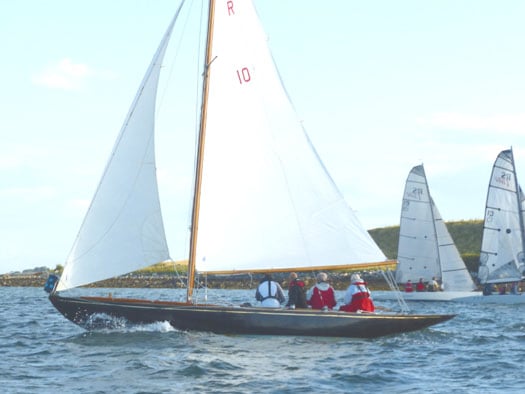
Two RS Elites shaping up for their start (right) closely watched for pointers for their own start by the crew of Brian Law's River class Uladh (foreground). Photo: W M Nixon

The SLYC Glen Class racing with Richard Aitken's Glenlark (right) well positioned on the favoured west side during the beat. Photo: W M Nixon
The Strangford Lough Glens are on something of a roll these days, as this past weekend (August 16th & 17th) they had their annual team racing series against the Dun Laoghaire Glens, and though it was an away match for the Whiterock squad which was captained by SLYC Commodore Ian Gleadhill, they won overall in a series which was curtailed by Sunday's foul weather.
As for the quality of the courses and the race management at Whiterock on the night of Wednesday 13th August, the photos speak for themselves. Racing started in a brisk and sunlit nor'wester, the course provided two excellent long beats and lots of spinnaker work, and it was all neatly wrapped up after sunset but with every boat finishing the course despite the dying breeze and gathering darkness. It was club evening racing at its very best, and the banter at the tasty post-race supper in the clubhouse rounded out an excellent programme.
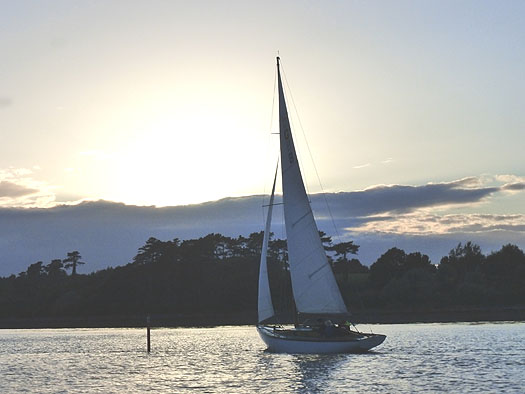
Evening racing timed to perfection. In the long-drawn-out northern sunset, Richard Aitken's Glenlark arrives in the lead at the weather mark. SLYC uses simple but clever ballasted plastic piping racemarks, and even when the tide is across them a displacement boat will find she has a very forgiving cushion of water between mark and boat when trying to shoot the turn. Photo: W M Nixon
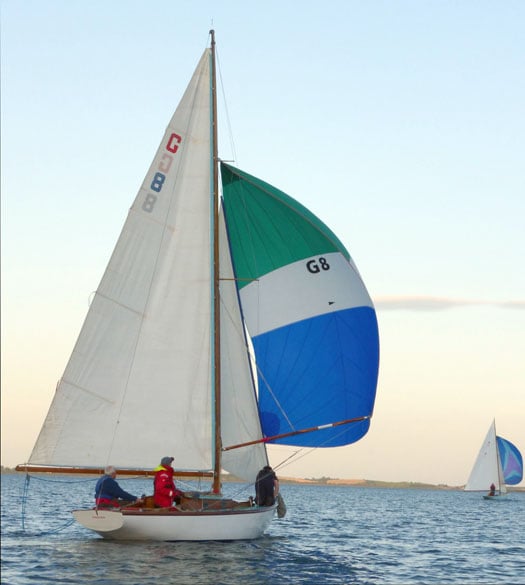
The last of the sunshine plays on the fields of the Ards Peninsula to the east as Glenlark consolidates her lead down the final run. Richard Aitken had read the beats so well he was up among the tail-end River Class boats. Photo: W M Nixon

